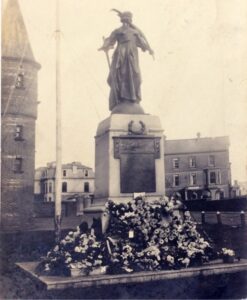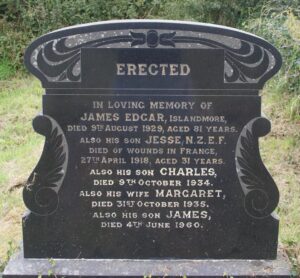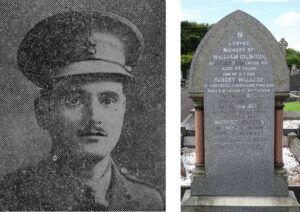Three civic war memorials were unveiled on Saturday 11th November 1922 at towns in counties Londonderry, Antrim, and Tyrone.
Portrush War Memorial
 The nine feet nine inch tall pedestal of Irish limestone is surmounted by a seven feet and six inches bronze figure of Victory, with inverted sword in her right hand and a palm branch in her left hand. The monument was designed by Sir George James Frampton and the bronze figure was sculpted by Frank Ransom, both of whom were from London. The monument was constructed by William Kirkpatrick Limited and unveiled by Lady Macnaghten who had lost two sons within three months during the war.
The nine feet nine inch tall pedestal of Irish limestone is surmounted by a seven feet and six inches bronze figure of Victory, with inverted sword in her right hand and a palm branch in her left hand. The monument was designed by Sir George James Frampton and the bronze figure was sculpted by Frank Ransom, both of whom were from London. The monument was constructed by William Kirkpatrick Limited and unveiled by Lady Macnaghten who had lost two sons within three months during the war.
Second Lieutenant Sir Edward Harry MacNaghten of 1st Battalion Black Watch was killed in action on 1st July 1916 at the age of 20 whilst attached to 12th Battalion Royal Irish Rifles. Second Lieutenant Sir Arthur Douglas MacNaghten was killed in action on 15th September 1916 at the age of 19 whilst serving with 8th Battalion Rifle Brigade.
 Sir James Craig presided over the ceremony and in his speech, he stated that 300 men from Portrush’s population of 3,000 had enlisted with the Ulster Division and that the Spirit of Ulster had carried those men through the most appalling time. There was no reference to the men who served and died with other units of the British, Dominion, and Empire forces. The names of the fallen were read by Captain Sydney James Lyle who had served with the 12th Battalion Royal Irish Rifles and 6th Divisional Train of the Royal Army Service Corps, being awarded the Military Cross. The memorial was dedicated by the Reverend James Gilbert Paton of Malone Presbyterian Church and formerly of Terrace Row Presbyterian Church in Coleraine. He had served as a Chaplain in the Ulster Division, being attached to the 10th Battalion Royal Inniskilling Fusiliers, and was awarded the Military Cross with two Bars.
Sir James Craig presided over the ceremony and in his speech, he stated that 300 men from Portrush’s population of 3,000 had enlisted with the Ulster Division and that the Spirit of Ulster had carried those men through the most appalling time. There was no reference to the men who served and died with other units of the British, Dominion, and Empire forces. The names of the fallen were read by Captain Sydney James Lyle who had served with the 12th Battalion Royal Irish Rifles and 6th Divisional Train of the Royal Army Service Corps, being awarded the Military Cross. The memorial was dedicated by the Reverend James Gilbert Paton of Malone Presbyterian Church and formerly of Terrace Row Presbyterian Church in Coleraine. He had served as a Chaplain in the Ulster Division, being attached to the 10th Battalion Royal Inniskilling Fusiliers, and was awarded the Military Cross with two Bars.
The bronze dedicatory plaque on the front face of the pedestal features a relief engraving depicting a seascape with three battleships and is surmounted by a victor’s laurel wreath. As can be seen from the two images, a different style of wreath in a slightly different position now adorns the memorial. The other three faces of the memorial now have bronze plaques recording the names of the Great War fatalities, but these plaques were not present when the memorial was unveiled. It is possible that the names of the fallen were originally engraved on the faces of the pedestal.
The memorial was erected at a cost of £1,300, which equates to approximately £57,200 in current terms.

Jesse Edgar was born on 28th December 1887 to James Edgar and Margaret Edgar (nee Forsythe) who farmed land at Islandmore townland. He was employed as a Policeman in Christchurch when he enlisted on 23rd August 1915 and was posted to the New Zealand Provost Corps. He was attached to the 1st Battalion Canterbury Regiment when it arrived at the Suez Canal in December 1915. He left Port Said for France in April 1916 and was transferred to the Mounted Military Police in October 1916. He was attached to the 1st Battalion Canterbury Regiment with the rank of Corporal when he sustained wounds to the head and abdomen and died at Number 29 Casualty Clearing Station on 27th April 1918. Jesse Edgar was 30 years old and is buried in Bagneux British Cemetery at Gezaincourt in France. Locally, he is also commemorated on a family memorial in Ballywillan Old Cemetery and on the memorial tablet in Ballywillan Presbyterian Church.
Coleraine War Memorial

After participating in the ceremony in Portrush, Sir James Craig and the Reverend James Gilbert Paton travelled a few miles south-west to unveil and dedicate the war memorial in Coleraine. In his opening remarks, Mr Daniel Hill Christie, Chairman of the Coleraine Urban District Council, said that Coleraine had contributed 1000 men, almost 13% of the entire population, to the forces of the Crown and this “record of patriotic duty was unsurpassed in the United Kingdom”. However, numerous other towns in Ulster made similar claims, including Ballymena and Lurgan. Mr Christie went on to report that 169 men gave their lives in the discharge of their duty. The memorial was dedicated by the Reverend James Gilbert Paton and the names of the fatalities were read out by Lieutenant Colonel Robert Sinclair Knox, formerly of the Royal Inniskilling Fusiliers. The names of the fallen were engraved on the faces of the pedestal and, at a later date, replaced with the current bronze tablets. Captain Knox was one of only seven officers from British, Dominion, and Empire forces to be awarded the Distinguished Service Order four times during the Great War.
The memorial is twenty-one feet and six inches high and features a bronze statue of a soldier in full battle uniform and wearing a cape with his rifle grounded. The statue is mounted on a pedestal of Portland stone and which features a bronze figure of Victory holding a laurel wreath above her head. The plinth is made from Irish granite and the memorial was designed by Frederick William Pomeroy and cost £1,800, which equates to approximately £79,230 in current terms.
 Robert Wallace Gilmour was born on 1st July 1885 at The Diamond in Coleraine where William Gilmour and Margaret Johnston Gilmour (nee Wallace) had a jewellery and watch-making business. Before the war, Robert Gilmour was employed as a Cashier in the Ulster Bank’s Pembroke branch in Dublin. He enlisted with the Connaught Rangers but was transferred to the Inns of Court Officers Training Corps and was commissioned into the Royal Inniskilling Fusiliers in December 1916. He was posted to 9th Battalion in France on 21st February 1917 and sustained gunshot wounds to the leg during the Battle of Messines. After a period of recuperation at home, Second Lieutenant Robert Wallace Gilmour returned to the Western Front and was Killed in Action during the German Spring Offensive in March 1918. He was 32 years of age and has no known grave, being commemorated on the Pozieres Memorial in France. Locally, he is commemorated on a family memorial in Coleraine Cemetery and on the memorial tablets for New Row Presbyterian Church in Coleraine and the Ulster Bank in Belfast.
Robert Wallace Gilmour was born on 1st July 1885 at The Diamond in Coleraine where William Gilmour and Margaret Johnston Gilmour (nee Wallace) had a jewellery and watch-making business. Before the war, Robert Gilmour was employed as a Cashier in the Ulster Bank’s Pembroke branch in Dublin. He enlisted with the Connaught Rangers but was transferred to the Inns of Court Officers Training Corps and was commissioned into the Royal Inniskilling Fusiliers in December 1916. He was posted to 9th Battalion in France on 21st February 1917 and sustained gunshot wounds to the leg during the Battle of Messines. After a period of recuperation at home, Second Lieutenant Robert Wallace Gilmour returned to the Western Front and was Killed in Action during the German Spring Offensive in March 1918. He was 32 years of age and has no known grave, being commemorated on the Pozieres Memorial in France. Locally, he is commemorated on a family memorial in Coleraine Cemetery and on the memorial tablets for New Row Presbyterian Church in Coleraine and the Ulster Bank in Belfast.
Dungannon War Memorial

The memorial, which is eighteen feet and six inches high, was designed by Frederick William Pomeroy and constructed by R Patton & Sons. It was erected at a cost of £1,700, which is approximately £74,800 in current terms. The memorial was unveiled by Constance Elizabeth Knox, Countess of Ranfurly, whose only son, Captain Thomas Uchter Knox, Viscount Northland, had been killed in action on 1st February 1915 whilst serving with the 11th Battalion Coldstream Guards. Brigadier-General Ambrose Ricardo gave the eulogy, and the names of the fallen were read out by Doctor Frederick Clark Mann, Chairman of Dungannon War Memorial Committee.
The memorial features a bronze statue of an army Sergeant in full battle uniform, holding a grounded rifle in his left hand and a standard in his right hand. The statue is eight feet and six inches high and is mounted on a pedestal of Stancliffe stone which sits on a granite plinth. The bronze dedicatory panel on the lower portion of the pedestal features a laurel wreath and palm fronds. The four faces of the pedestal bear bronze panels on which names of the fallen are recorded, with the fatalities from the Royal Inniskillings Fusiliers being listed first.
 Three females are commemorated on the memorial – Staff Nurse Emily Gray of the Queen Alexandra’s Imperial Military Nursing Service, Alicia Watt of the Queen Mary’s Army Auxiliary Corps, and Nurse Frances Emma Shortt of the Voluntary Aid Detachment. Frances Shortt was only added to the Commonwealth War Graves Commission database in recent years and a CWGC headstone was installed in the graveyard at Tullanisken Parish Church in Newmills in October 2022. The recognition of Nurse Shortt as an official war fatality was largely due the efforts of Kenneth Farquhar of Dungannon.
Three females are commemorated on the memorial – Staff Nurse Emily Gray of the Queen Alexandra’s Imperial Military Nursing Service, Alicia Watt of the Queen Mary’s Army Auxiliary Corps, and Nurse Frances Emma Shortt of the Voluntary Aid Detachment. Frances Shortt was only added to the Commonwealth War Graves Commission database in recent years and a CWGC headstone was installed in the graveyard at Tullanisken Parish Church in Newmills in October 2022. The recognition of Nurse Shortt as an official war fatality was largely due the efforts of Kenneth Farquhar of Dungannon.
Frances Emma Shortt was born on 22nd April 1864 at Curran near Dungannon to Hugh Shortt and Elizabeth Short (nee Simpson). Hugh Shortt died on 2nd March 1892 and Elizabeth married John Greenhalgh on 2nd February 1898. In 1901, Frances and her sister Harriet were living at Market House Street in Limavady and were recorded as being drapers. In 1911, Harriet was living with her mother and step-father at Curran and Frances was lodging with the Erskine family at High Street West in Sligo, and was a Milliner in Joseph Erskine’s drapery business. Frances Shortt volunteered for war service as a Nurse on 9th August 1918, her age being recorded as 31. Nurse Frances Shortt died at the Bermondsey Military Hospital in Lewisham on 26th December 1918, aged 54 in lay in an unmarked grave for nearly 104 years.
